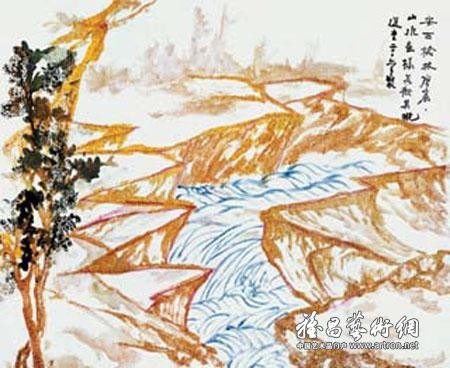
Master Displays Artistic Works on Dunhuang Culture
2009-02-05 09:11:54 未知

Poet, calligrapher and painter Jao Tsung-I is exhibiting more than 80 paintings and calligraphic works featuring Dunhuang culture at the Shenzhen Art Museum.
A versatile scholar, Jao, 92, has contributed many fields in the humanities, including archaeology, literature, philosophy, musicology and history.
"It is significant to hold the Dunhuang exhibition in Shenzhen," said Jao during the opening ceremony on Jan. 16.
According to his latest published research, "Preface of Li Zhengwu Han Tomb," Shenzhen was a crucial geographic location for China's Marine Silk Road back in the Han Dynasty (206 B.C.-220 A.D.). The Marine Silk Road was almost in the same period as the development of the Silk Road in the northwest part of the country. Human settlements appeared in the Shenzhen region as early as East Han Dynasty (25-220 A.D.).
"I feel deeply connected with the city of Shenzhen," said Jao.
Located in Northwest Gansu Province, Dunhuang is a noted tourist attraction surrounded by high sand dunes. The Mogao Grottoes are at nearby Qianfodong. The town and its surroundings were long a gateway between central Asia and China. The frescoes in the caves, painted from the fifth through the 13th centuries, show Indian, Greco-Roman and Iranian influences.
After moving to Hong Kong in 1949, Jao started his Dunhuang research in the 1950s when Dunhuang was still unknown to the academic field in China. Jao was able to purchase a whole set of negatives taken by Marc Aurel Stein. Between 1900 and 1930 Stein carried out four expeditions to Chinese Central Asia, conducting excavations along the whole of the Southern Silk Road, at Dunhuang and Turfan, as well as surveying, photographing and conducting ethnographical surveys.
Jao was deeply intrigued by the Dunhuang scripts shown on the negatives. In the 1960s, an opportunity came allowing Jao to undertake research on Dunhuang at the Paris Science Museum.
Among piles of Dunhuang scripts, Jao discovered a series of drawings consisted of a unique art style, which he called "Dunhuang Sketches". The drawings were based a brush technique in Chinese painting. It produces a finely controlled, supple ink outline drawing without any colour or wash. It is commonly used for figure painting, in which precise description is important.
Inspired by Dunhuang Art, Jao later created his own style of painting and calligraphy.
In the field of painting, he draws on the brush and ink technique of the great masters. He travels extensively to sketch nature. His figure painting draws on inspiration of the Dunhuang caves while his flower and bird paintings have evolved with a distinctive flavor of his own.
His calligraphy exhibits a unique quality with reference to inscriptions on tombstones of the Han (B.C. 206-220 A.D.), the Northern Wei (386-534) and the Tang Dynasty (618-907) as well as manuscripts of the Song (960-1279) and the late Ming Dynasty (1368-1644).
Among the 80 exquisite pieces included in the exhibition, "Buddha in Gold-line Sketch Style" is a combination of the Dunhuang sketches and Jao's calligraphy work. Pieces also include the "Lotus in Red Ink," "Landscape in Tang Dynasty" and the "Buddhist Poem of Monk Zhiqin."
One of his masterpieces is his calligraphic work, "The Poem of Gao Shi." Gao Shi (702-765), was a military veteran and also a famous poet in the Tang Dynasty. Gao's poems are simple, powerful and heroic. Jao successfully integrated the spirit of Gao's poetry with his own calligraphy based on the Tang style.
Born into a wealthy family in Chaozhou, Guangdong Province, Jao is largely an autodidact, who began to publish scholarly works at a young age. Later, he was invited to work as lecturer and researcher in a number of colleges on the mainland.
After 1949, he taught at the University of Hong Kong after where he learned Sanskrit from the Indian diplomat and Chinese expert V.V. Paranjpe, who in turn learned ancient Chinese from Jao. In 1959, Jao published "Oracle Bone Diviners of the Yin Dynasty," which later earned him the Prix Stadislas Julien from the Academic des Inscriptions et Belles-Lettres.
From 1963, Jao traveled to research and teach, in India, France, Singapore, the United States and Japan. He was awarded an honorary degree of Doctor of Letters by Ecole Pratique des Hautes Etudes, France, and Officer de L'ordre des Arts et des Letters by the Ministry of Culture, France in 1993. The Hong Kong Arts Development Council bestowed on him the First Emeritus Fellowship in 1997.
Since 1978, he has held more than 20 solo exhibitions in Hong Kong, South East Asia, Japan and China, and has published over 10 albums. He has obtained honorary doctorates from various Hong Kong universities: The University of Hong Kong (1982); Lingnan University (1995); Open University of Hong Kong (1999). Jao was also the recipient of the Grand Bauhinia Medal granted by the Hong Kong SAR government, and the Prize of Special Contributions to the Protection of Dunhuang Relics by the People's Government of Gansu Province and the National Bureau of Relics, China, in 2000.
He is currently Wei Lun Honorary Professor of Chinese Language and Literature at the Chinese University of Hong Kong.
Many of his works are pioneering. For instance, he is the first scholar to render the Babylonian epic Enuma Elish into Chinese, after learning the Akkadian language from Jean Bottéro while he was a visiting scholar in Paris, He was also the first to make a comparative study of the oracle bone script and the Indus script.
Yu Qiuyu, a popular mainland writer, once said publicly that "with the presence of Jao Tsung-I, Hong Kong would not be a cultural desert," reacting to the common opinion that the region is a utilitarian cultural desert.
(责任编辑:李丹丹)
注:本站上发表的所有内容,均为原作者的观点,不代表雅昌艺术网的立场,也不代表雅昌艺术网的价值判断。
 翟莫梵:绘画少年的广阔天空
翟莫梵:绘画少年的广阔天空 OCAT上海馆:参与构建上海艺术生态的十年
OCAT上海馆:参与构建上海艺术生态的十年 春雨斋主人房茂梁:“好运气”的90后古玩经纪人
春雨斋主人房茂梁:“好运气”的90后古玩经纪人 周杰伦都要去的伦敦弗里兹,到底有多火爆?
周杰伦都要去的伦敦弗里兹,到底有多火爆?
全部评论 (0)